Japan Trip 2010–Day 8
Jetlag, insomnia, overstimulation and exposure to the elements caught up with me during the first night in our modest but comfortable Kyoto hotel, inflicting a sore throat that I feared would turn into serious illness. But morning sunshine and the cheerful greeting of Maya garbed in kimono lifted my spirits.

She too was puffy with a cold. On the way to our first destination she told us of the special distinction of Kyoto, Japan’s capital and the seat of the Emperor until it moved to Tokyo, its anagram, in 1867. It was laid out in a grid a thousand years earlier and still had building restrictions against skyscrapers to preserve views of the hills and the prominence of its more than 2000 temples and shrines. Three hundred varieties of flowering cherry trees bloomed here. The city was spared bombing in World War II only because of the intervention of Henry Stimson, Secretary of War, who had an appreciation for its beauty.
First stop was a prominent one of those temples known as Sanjusanjendo, founded in 1164 and rebuilt in its present form in 1266, which appeared contemporary in its clean lines and spare ornamentation.
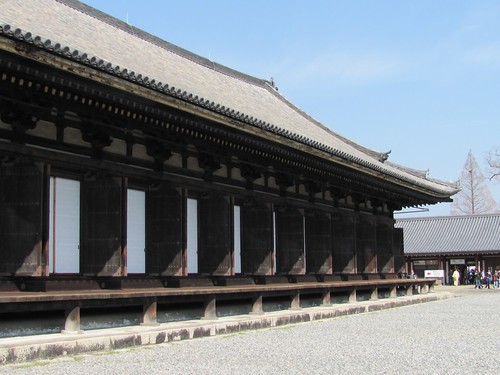
Removing shoes at the entry, we followed the crowd into a dark 390 foot passageway that faced an array of gold-covered larger-than-life-sized boddhisatvas, 200 long and five deep on ascending risers, each in an identical position, with a serene but individual expression. Looked at face-on, their interlocking radiances created a dizzying visual buzz, looked at diagonally they lined up like rows of corn. In front of every fifth one of these stood a bigger figure of a Hindu god in a twisted position with a ferocious look, drapery flying and weapon brandished. Their remarkable realism and fluidity reminded me of the baroque sculptures of Bernini, though carved 500 years earlier. As we approached the middle of the gallery we heard gongs and chants and smelled incense. Monks were praying before a huge statue of “Eka-Dasa-mukha-sahasra-bhuja-Avalokite-svara” or Kannon, the hermaphrodic Buddha of mercy, with eleven faces and 20 pairs of arms. I tossed a 50-yen coin into the box and begged for relief from illness and forgiveness for being cheap.
Outside in the brilliant sun, the cherry blossoms were in full bloom.

On we traveled across town and up to the range of forested mountains enclosing it on the east. Led by Maya’s wand, now hard to distinguish from the blooming background, we joined the throng climbing the steep shop-lined streets leading up to the Kiyumizo Dera temple complex.

By contrast to the somber and flat temple we’d left, this place was noisy, exuberant and vertical, steep steps leading to terrace upon terrace, views of the city below opening wider, people at the lower levels appearing tiny at the base of vertiginous foundations and stone walls.
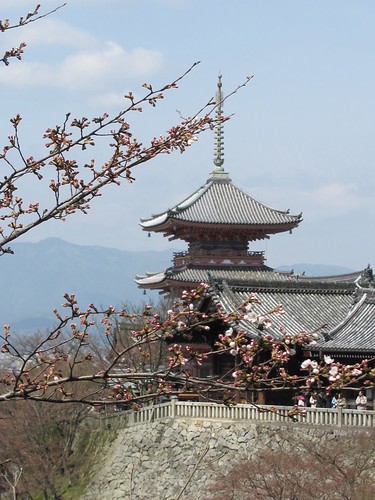
This was a place, said Maya, where individuals come to find mates and couples to ask for fertility.
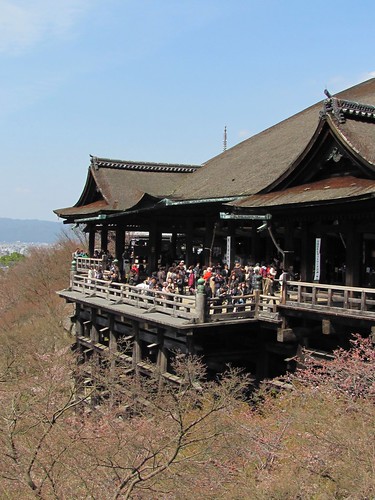
Up this high the blossoms were just starting to burst and I got to see what I’d been looking for since Kanazawa, evidence of the armies of arborists who must be deployed to do the continual meticulous trimming of trees. They worked as a crew with ladders and small saws, deliberating over each cut and hand bundling every twig.
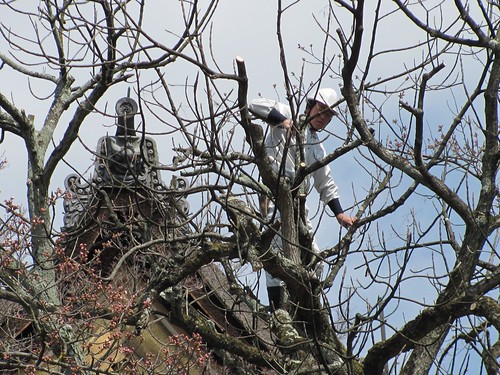
Another smart contrast was provided by our next destination, Ninjo Castle, a samurai fortress built by the Shogun military dictatorship in 1625. Surrounded by a wide outer and inner moat and two sets of forbidding stone walls, it reminded me of the Castle in Kanazawa.
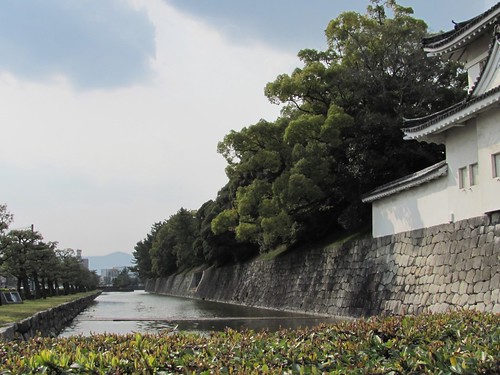
No cherry trees here and the weather darkened. More old wood and murals of gnarled pine trees on gold leaf background representing long life, strength and evergreen vitality. The rooms were designed like those in the ryokan, spare, with tatami mats, sochi screens, alcoves and decorated ceilings, but on a gargantuan scale, the walls 20 feet high, the porticoes, which squeaked deliberately to warn of assassins, fifteen feet wide, the footprint of the building 27000 square feet. Each chamber had different murals, less formal, more intimate as one moved from the forbidding atmosphere of the hall where the Shogun received his feudal vassals to the private quarters where he was entertained by geishas and consorts. But every room, we were told, included a bell pull and hidden door behind which soldiers waited to be summoned at a moment in the event of threat.
We had time only for a brief visit to the splendid but appropriately austere gardens outside, devoid of flowers and adorned with artfully placed rocks imported from the far corners of the country.
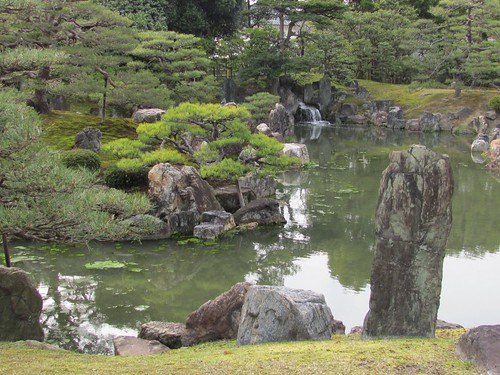
An excellent lunch of French cuisine”the bread as good as any in Paris–was served in a small dining room off a larger restaurant at Kyoto University. The walk there from the bus allowed an even briefer taste of the academic atmosphere of what Maya said was probably Japan’s most prestigious institution of higher learning.
We arrived at our final destination just before the gates closed: Kinkakuji, the Temple of the Golden Pavilion, built in 1397 as a retirement villa for a Shogun and converted by his son to a Zen temple.

It’s famous for its exquisite architecture and gardens and also as a cause celebre, since it was burned down by a deranged monk in 1954, the subject of a novel by You-kio Mishima (my favorite Japanese writer), and then rebuilt quickly with publicly donated funds. Even after a day packed with enough highlights for a week and observed among crowds, the beauty of this place was deeply stirring. Taking pictures and returning to them, I was grateful to the camera for filtering and arranging the views.
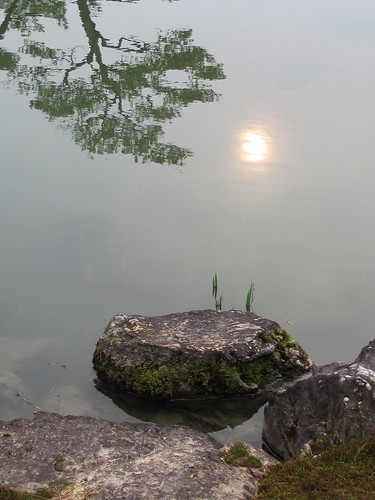
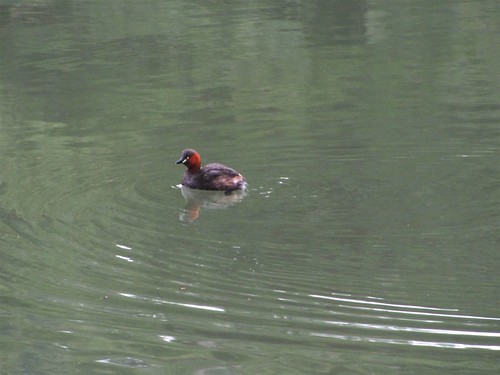
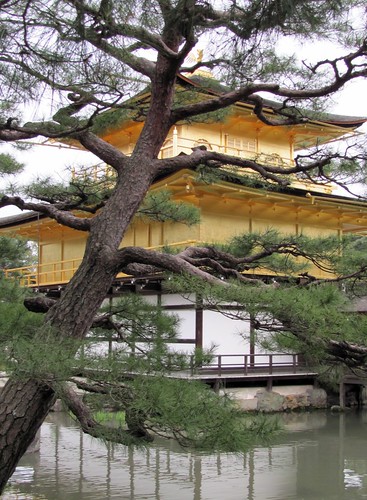
After a needed rest back at the hotel, Jan and I wandered through narrow streets off the main boulevard of Kyoto looking for food. An unassuming little place with bikes parked outside attracted our attention, and we found a reasonably priced dinner of eggplant in a lemony sauce and rice served by a shy and handsome young waiter.
